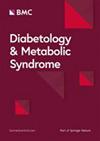High-density lipoprotein cholesterol trajectory and new-onset metabolic dysfunction-associated fatty liver disease incidence: a longitudinal study
IF 3.4
3区 医学
Q2 ENDOCRINOLOGY & METABOLISM
引用次数: 0
Abstract
Although high-density lipoprotein cholesterol (HDL-C) exerts a significant influence on the development of metabolic dysfunction-associated fatty liver disease (MAFLD), the association of dynamic changes in HDL-C levels with the risk of MAFLD remains unclear. Thus, the aim of the current study was to explore the association between the changing trajectories of HDL-C and new-onset MAFLD. The findings of this study may provide a theoretical basis for future personalized intervention and prevention targeting MAFLD. A total of 1507 participants who met the inclusion criteria were recruited from a community-based physical examination population in Nanjing, China from 2017 to 2021. Group-based trajectory models were constructed to determine the heterogeneous HDL-C trajectories. The incidence of MAFLD in each group in 2022 was followed up, and the Cox proportional hazards regression model was applied to investigate the associations between different HDL-C trajectories and the risk of new-onset MAFLD. The incidences of MAFLD in the low-stable, moderate-stable, moderate-high-stable, and high-stable groups of HDL-C trajectory were 26.5%, 13.8%, 7.2% and 2.6%, respectively. The incidence rate of MAFLD in the order of the above trajectory groups exhibited a decreasing trend (χ2 = 72.55, Ptrend<0.001). After adjusting for confounders, the risk of MAFLD onset in HDL-C low-stable group was still 5.421 times (95%CI: 1.303–22.554, P = 0.020) higher than that in the high-stable group. Subgroup analyses of the combined (moderate high-stable and high-stable groups combined), moderate-stable and low-stable groups showed that sex, age, and overweight/obesity did not affect the association between HDL-C trajectory and MAFLD risk. Persistently low HDL-C level is a risk factor for the onset of MAFLD. Long-term monitoring of HDL-C levels and timely intervention for those experiencing persistent declines are crucial for early prevention of MAFLD.高密度脂蛋白胆固醇轨迹与新发代谢功能障碍相关脂肪肝发病率:一项纵向研究
虽然高密度脂蛋白胆固醇(HDL-C)对代谢功能障碍相关性脂肪肝(MAFLD)的发生有重要影响,但 HDL-C 水平的动态变化与 MAFLD 风险之间的关系仍不清楚。因此,本研究旨在探讨 HDL-C 的变化轨迹与新发 MAFLD 之间的关联。本研究的结果可为未来针对 MAFLD 的个性化干预和预防提供理论依据。2017年至2021年,我们从中国南京的社区体检人群中招募了1507名符合纳入标准的参与者。通过构建基于群体的轨迹模型来确定异质性HDL-C轨迹。对2022年各组MAFLD的发病率进行随访,并应用Cox比例危险回归模型研究不同HDL-C轨迹与新发MAFLD风险之间的关联。HDL-C轨迹低稳定组、中稳定组、中高稳定组和高稳定组的MAFLD发病率分别为26.5%、13.8%、7.2%和2.6%。MAFLD的发病率按上述轨迹组依次呈下降趋势(χ2 = 72.55,Ptrend<0.001)。调整混杂因素后,HDL-C 低稳定组的 MAFLD 发病风险仍是高稳定组的 5.421 倍(95%CI:1.303-22.554,P = 0.020)。对合并组(中度高稳定组和高度稳定组合并)、中度稳定组和低稳定组进行的亚组分析表明,性别、年龄和超重/肥胖并不影响 HDL-C 轨迹与 MAFLD 风险之间的关联。HDL-C水平持续偏低是MAFLD发病的一个风险因素。长期监测 HDL-C 水平并及时干预那些出现持续下降的人群对于早期预防 MAFLD 至关重要。
本文章由计算机程序翻译,如有差异,请以英文原文为准。
求助全文
约1分钟内获得全文
求助全文
来源期刊

Diabetology & Metabolic Syndrome
ENDOCRINOLOGY & METABOLISM-
CiteScore
6.20
自引率
0.00%
发文量
170
审稿时长
7.5 months
期刊介绍:
Diabetology & Metabolic Syndrome publishes articles on all aspects of the pathophysiology of diabetes and metabolic syndrome.
By publishing original material exploring any area of laboratory, animal or clinical research into diabetes and metabolic syndrome, the journal offers a high-visibility forum for new insights and discussions into the issues of importance to the relevant community.
 求助内容:
求助内容: 应助结果提醒方式:
应助结果提醒方式:


